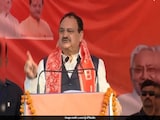From strategic corridors for boosting high-speed connectivity to redevelopment of the historic ring rail network, the draft Master Plan of Delhi 2041 envisions a future of mobility in the city driven by intelligent technology that will encourage use of public transport.
The draft MPD 2041 has been made available on the website of the Delhi Development Authority and public suggestions and objections have been invited, a senior DDA official said on Wednesday.
The draft delineates that public transport system of Delhi needs further integration at institutional-level, spatial-level and at systems-level; to provide a seamless travel experience to the commuters.
"Institutional integration could be enabled by a larger mandate, efforts towards achieving spatial integration (land use and transport integration, multi modal integration, last mile connectivity, among others) and systems integration (bus route rationalisation, intelligent transport systems, including unified ticketing, command and control center for better traffic management), have been initiated, but need to be reinforced," it said.
The draft also said that efficiency of urban transport is heavily dependent upon "seamless integration" between various road-based, rail-based, intermediate public transport (IPT) and walking or cycling systems.
"A Comprehensive Mobility Plan (CMP) shall be prepared for Delhi to achieve systemic integration across all levels and modes of urban transport. The CMP shall be aligned with the provisions of MPD 2041 and shall provide a detailed road map for achieving the transformative agenda of ''moving towards low-carbon mobility''," it said.
The draft Master Plan, which will lay the roadmap for the next 20 years, says to improve high-speed connectivity to and from important regional destinations and decongest traffic within the city (particularly due to regional traffic) following "strategic transport corridors" were identified to be implemented in this plan period.
The strategic links shall be developed as "transit-priority corridors" to facilitate movement of passengers and freight, it said.
The three links proposed as part of these corridors are -- northern extension of UER (Urban Extension Road) II, southern extension of UER II, and Bahadurgarh to Bijwasan, the plan said.
Among other key elements of the segment related to transport is redevelopment of the historic Ring Rail network in Delhi that has been lying underutilised for decades.
"Ring Rail is a legacy infrastructure of Delhi and it plays a significant role in freight transport. However, the passenger ridership is low. In order to increase its ridership, accessibility improvements may be implemented for the major halt stations by creating public plazas, providing walking and cycling infrastructure, and installation of proper signage," the draft plan said.
Interchange facilities may be planned for integrating Ring Rail stations with existing metro stations.
"The Ring Rail alignment connects areas of heritage, ecological assets of Delhi and many commercial areas, a special hop-on and hop-off service may be considered for movement of tourists," it added.
The draft also envisions smarter transportation, saying intelligent transport system (ITS) shall use "data repository and artificial intelligence" to play a major role in improving the efficiency and coordination among different transport modes and systems in the city.
"A Mobility Data Repository (MDR) should be set up for Delhi, where reliable and accurate data pertaining to traffic volume and O-D trends, accident hotspots, congestion, freight traffic, can be made available in an integrated framework. Data collated from different transit agencies shall be standardised and regularly updated through surveys and information," it said.
Smart solutions through ITS will enable use of real-time data for forecasting and mitigating potential challenges, use of predictive technologies for dynamic and efficient management of public transport fleet operations, system integration, and providing real-time information to commuters, to enhance the resilience of transportation systems, the draft plan said.
Also, utilisation of ITS for pre-warning and minimising response time of emergency vehicles (ambulance, fire tender etc.) by ensuring uninterrupted movement from source to destination, it added.
The draft MPD 2041 also laid emphasis on multimodal integration of transport systems with seamless integration across various modes to be facilitated at transit stations (metro, RRTS, railway station, Ring Rail) and major bus terminals in Delhi, as also on improved bus transportation system with premium bus services and special bus services.
"The plan targets at night time economies to promote higher economic productivity as well as increasing the availability of vibrant and safe public spaces at night. The DMRC and DTC to be encouraged to operate low frequency night time services along specific earmarked routes and networks across the city or for special events or festivals as per feasibility," it said.
Mobility trends in the future will lean towards electrification, shared mobility, mobility on demand and autonomy; therefore, it becomes important for Delhi to "change gears from building for transport to managing travel demand".
Additionally, the TOD (transit-oriented development) Policy and electric vehicle policy also find mention in the draft plan.
"It will be critical to complement the various initiatives aimed at increasing the use of shared modes with hard regulatory strategies focused on disincentivising private modes of transport," it said.
This Plan proposes following three major strategies that are aimed at curbing the use of private vehicles, including congestion pricing, parking demand management and prioritising pedestrians and cyclists.
(Except for the headline, this story has not been edited by NDTV staff and is published from a syndicated feed.)















